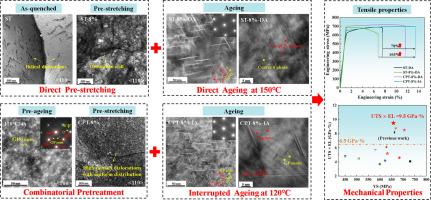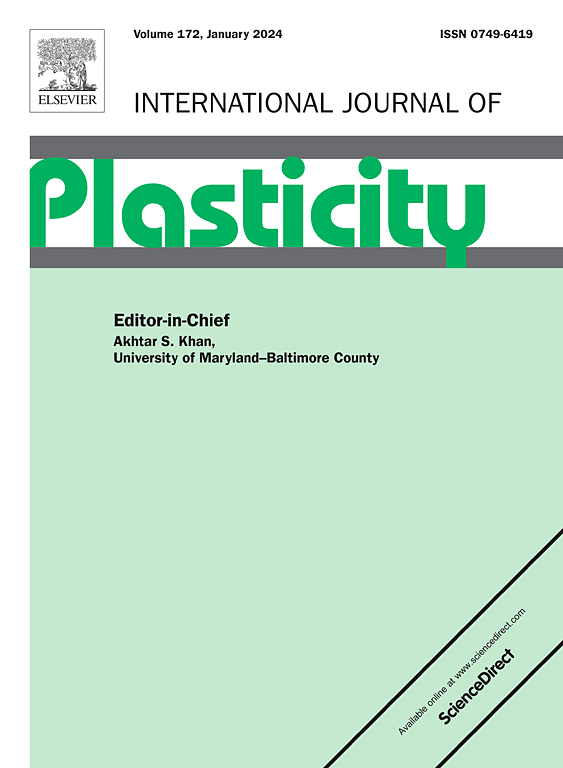Achieving superior strength-ductility balance by tailoring dislocation density and shearable GP zone of extruded Al-Cu-Li alloy
IF 12.8
1区 材料科学
Q1 ENGINEERING, MECHANICAL
引用次数: 0
Abstract
Pre-stretching is commonly employed to accelerate ageing precipitation kinetics in wrought Al-Cu-Li alloys, but uneven precipitation resulting from dislocation pile-ups often degrades ductility. Herein, the strength and ductility of extruded Al-Cu-Li alloy are significantly improved through a novel thermomechanical treatment, involving pre-ageing and pre-stretching, followed by low-temperature interrupted ageing. A superior balance between high yield strength (∼ 657 MPa) and good ductility (elongation to fracture of ∼ 13.5 %) is obtained, with elongation increased by 105 % compared to the conventional T8 temper, while maintaining a respectable yield strength. Microstructure analysis reveals that dense Guinier–Preston (GP) zones induced by pre-ageing effectively dissipate energy from dislocation sliding, resulting in a uniform dislocation configuration even at 8 % pre-stretching. However, the GP zone density is greatly reduced due to their dissolution following pre-stretching. Upon interrupted ageing, the reprecipitation of GP zones forms a homogeneous mixture of δ′, GP zones, and T1 phases. This combination alleviates local stress concentrations and lengthens the dislocation mean free path during tensile testing by shearing the GP zones at multiple sites, thereby improving ductility. Simultaneously, T1 precipitates strengthen the alloy by pinning dislocations and promoting dislocation cross-slip, improving work hardening capacity. The dissolution of GP zones also redistributes the Cu atoms within the matrix, further enhancing the intrinsic ductility of the Al matrix. These findings offer valuable insights for developing high-performance wrought Al-Cu-Li alloys.

通过调整挤压铝-铜-锂合金的位错密度和可剪切 GP 区,实现卓越的强度-电导率平衡
预拉伸通常用于加速锻造铝-铜-锂合金的时效析出动力学,但位错堆积导致的不均匀析出往往会降低延展性。在本文中,挤压铝-铜-锂合金的强度和延展性通过一种新的热机械处理方法得到了显著改善,包括预时效和预拉伸,然后是低温间断时效。在高屈服强度(657 兆帕)和良好延展性(断裂伸长率为 13.5%)之间取得了极佳的平衡,与传统的 T8 回火相比,在保持可观的屈服强度的同时,伸长率提高了 105%。显微结构分析表明,预时效诱导的致密吉尼耶-普雷斯顿(GP)区可有效消散位错滑动产生的能量,即使在 8% 预拉伸时也能形成均匀的位错配置。然而,由于预拉伸后 GP 区的溶解,其密度大大降低。间断时效后,GP 区的再沉淀形成了δ′、GP 区和 T1 相的均匀混合物。在拉伸测试过程中,这种组合通过在多个位置剪切 GP 区,缓解了局部应力集中,延长了位错的平均自由路径,从而提高了延展性。同时,T1析出物通过钉住位错和促进位错交叉滑移来强化合金,从而提高加工硬化能力。GP 区的溶解还重新分配了基体中的铜原子,进一步增强了铝基体的内在延展性。这些发现为开发高性能锻造铝-铜-锂合金提供了宝贵的见解。
本文章由计算机程序翻译,如有差异,请以英文原文为准。
求助全文
约1分钟内获得全文
求助全文
来源期刊

International Journal of Plasticity
工程技术-材料科学:综合
CiteScore
15.30
自引率
26.50%
发文量
256
审稿时长
46 days
期刊介绍:
International Journal of Plasticity aims to present original research encompassing all facets of plastic deformation, damage, and fracture behavior in both isotropic and anisotropic solids. This includes exploring the thermodynamics of plasticity and fracture, continuum theory, and macroscopic as well as microscopic phenomena.
Topics of interest span the plastic behavior of single crystals and polycrystalline metals, ceramics, rocks, soils, composites, nanocrystalline and microelectronics materials, shape memory alloys, ferroelectric ceramics, thin films, and polymers. Additionally, the journal covers plasticity aspects of failure and fracture mechanics. Contributions involving significant experimental, numerical, or theoretical advancements that enhance the understanding of the plastic behavior of solids are particularly valued. Papers addressing the modeling of finite nonlinear elastic deformation, bearing similarities to the modeling of plastic deformation, are also welcomed.
 求助内容:
求助内容: 应助结果提醒方式:
应助结果提醒方式:


